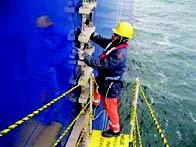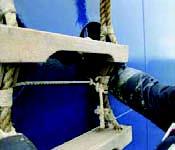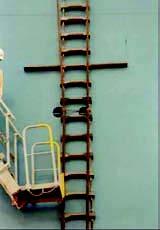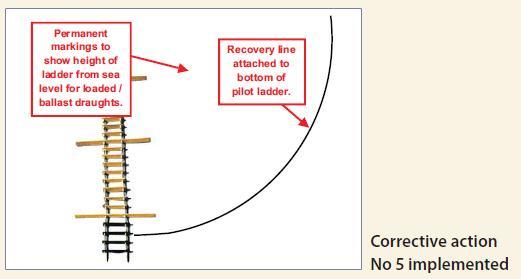201229 Arm fractured when rigging pilot ladder
A large inbound vessel was approaching the pilot station in a gale and heavy rain and was instructed to prepare combination ladders on both sides. The C/O and deck crew held a toolbox meeting and prepared the port (weather) side combination ladder first. The gangway was rigged at deck level, and then lowered to the proper height. Next, a seaman wearing all appropriate PPE, including an inflatable life vest and safety harness with lifeline, descended to the bottom platform of the gangway to monitor the lowering of the pilot ladder. After confirming the pilot ladder was 1.5 metres above the water, he began to secure the pilot ladder to two sunken cleats in the hull with an 8mm rope lashing. When he inserted his right hand into the after sunken cleat to thread the rope through it, a wave caught the bottom of the pilot ladder and jerked it astern. The step in the way of the sunken cleat moved aft and hit the seaman’s right wrist, whilst his hand was still inside the recess. Although in severe pain, he managed to return to the accommodation where first aid was given by the ship’s medical officer. Immediately after berthing, the injured crew was sent ashore and the doctor diagnosed a bone fracture (right ulna), ligament injury and subcutaneous haematoma. The crewmember was certified unfit for duty and was disembarked.
Root cause/contributory factors
1 Although a proper risk assessment and toolbox meeting was conducted before work, it did not consider the possibility and consequences of the bottom steps of the ladder being hit by a swell wave;
2 A combination of wind direction, restricted sea room, traffic density and routeing prevented a change of heading to provide sufficient lee for rigging the combination ladders;
3 Constraints of the working area – in order to secure the pilot ladder to the sunken cleats, the crewmember had to stand on the bottom step of the gangway and pass the lashing rope around both the pilot ladder’s side ropes and twice around the far cleat before tying it off.
Corrective/preventative actions
Pilot combination ladder rigging procedures revised as follows:
1 Gangway to be lowered to designed level (≤ 55° angle above horizontal);
2 Pilot ladder rope lashing changed from 8mm to 16mm since the larger rope requires only one turn around the ladder and cleat;
3 T he fore side of the pilot ladder to be lashed fifirst and then the aft side;
4 During rigging and unrigging operation, the pilot ladder’s bottom steps shall be kept at least 4 metres above the sea level by means of the recovery line;
5 Pilot ladder marked to indicate at upper deck one, two and three metre clearances from ladder bottom to sea level for both ballast and laden conditions.

|

|

|
| Seaman securing pilot ladder to sunken cleats |
Reconstruction of incident showing how the step impacted on seaman’s arm |
View of combination ladder arrangement |

Editor’s note: If the pilot transfer craft has sufficient freeboard, under rough sea conditions and with the pilot’s agreement, it would be safer to keep the bottom of the ladder higher than 1.5 metres above the water. Instead of rope lashings that need to be passed around the ropes and cleats and tied off, ‘karabiner’ type quick-release hooks or shackles with a short rope grommet or sling will be more practical, allowing the crew to simply wrap the rope around the ladder and clip the hook either on to its own rope or on to the sunken cleat. For safety reasons, some pilotage authorities do not permit the use of recovery or tripping lines at the bottom of pilot ladders. Where permitted, the ship’s crew must ensure that this line is led well clear of the ladder and away from the gangway section of a combination arrangement, and kept under adequate tension so that it does not snag or foul the hull of the pilot boat or launch.
Feedback from IMPA
The International Marine Pilots Association (IMPA) has pointed out that combination ladders for pilot transfer must comply with Section 2.1.5 of IMO Resolution A.1045(27), which requires, among other things, that retrieval / recovery / tripping lines should be attached at or above the lowest spreader and lead forward. The latest version of the IMPA pilot ladder poster was featured in Seaways - August 2012
